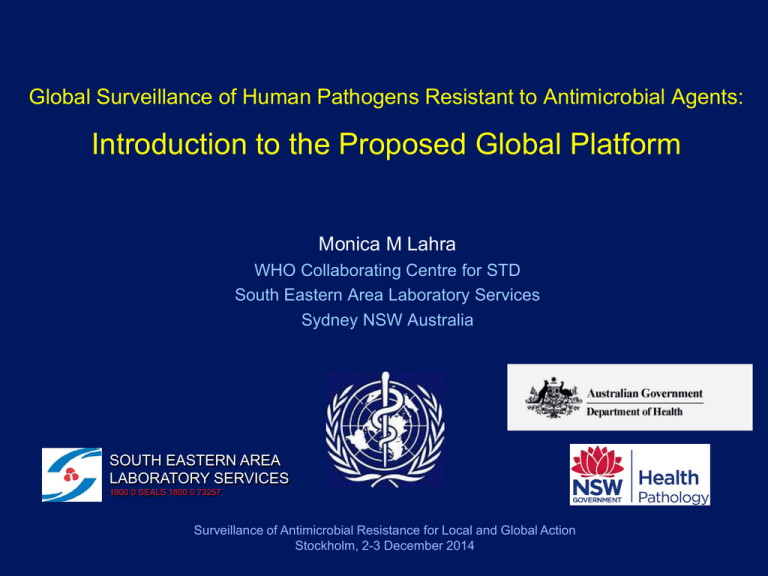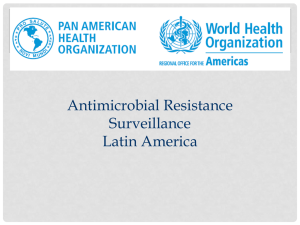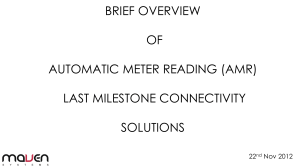Introduction to the Proposed Global Platform: Global Surveillance of
advertisement

Global Surveillance of Human Pathogens Resistant to Antimicrobial Agents: Introduction to the Proposed Global Platform Monica M Lahra WHO Collaborating Centre for STD South Eastern Area Laboratory Services Sydney NSW Australia SOUTH EASTERN AREA LABORATORY SERVICES 1800 0 SEALS 1800 0 73257 Surveillance of Antimicrobial Resistance for Local and Global Action Stockholm, 2-3 December 2014 Antimicrobial Resistance (AMR) • A threat to global health security. • Associated increased morbidity, mortality, costs to health systems • Calls for urgent action: develop, improve, enhance surveillance WHO AMR Global Report on Surveillance 2014 Identified Key Gaps in: • coordinated global AMR surveillance • population-based AMR surveillance • methodology and integrated surveillance • coordination amongst existing networks to support collaboration http://www.who.int/drugresistance/documents/surveillancereport/en/ 5 Moving towards Global AMR Surveillance: establishing Standards and a Collaborative Platform http://bmdp.org/wp-content/uploads/2013/12/164-moving-forward-389.jpg General Functions of AMR Surveillance: determine the burden of AMR monitor trends in AMR inform treatment guidelines provide evidence to underpin public health strategies monitor impact of interventions detect incursion of resistant strains http://michelsonmedical.org/2014/11/13/unique-antibiotic-mechanism-developed/ http://33q47o1cmnk34cvwth15pbvt120l.wpengine.netdna-cdn.com/wp-content/uploads/bottle-of-antibiotics-320x213.jpg 7 WHO Global AMR Surveillance • A foundation to monitor national, regional and global AMR • Based on a Collaborative Platform for Member States • To address AMR in a coordinated and cohesive manner • Standardised metrics; quality assured, validated data Initial Implementation of Global AMR Surveillance Proposed Framework for Initial Implementation 2015: 1. Identify Member States ready to i. meet laboratories standards requirements ii. participate in initial phase 2. Invitation to participate through an MOU 3. Submission of aggregate data 4. Review, analysis and initial Report of WHO Global AMR Surveillance 5. Review, analysis and expansion of WHO Global AMR Surveillance Building Global Surveillance: Collaboration for Global Surveillance of AMR Principle: to evaluate AMR indicators globally in a standardised manner WHO will coordinate and manage a Global AMR Collaborative Platform Member States National and Regional Networks of: Collaborating Centres Laboratories Institutions Enhanced collaboration with FAO and OIE: integrated surveillance: human, animal health and agriculture WHO Global AMR Collaborative Platform Aims of the Global AMR Collaborative Platform : • collect, analyse comparable, validated AMR data • share information for decision making + advocacy + action • support capacity building; provide guidance to address gaps • overview of available technical and human resources • facilitate networking across sectors nationally, internationally 11 WHO Global Collaboration: IT Platform Collaboration: requires Principles and Processes Information Technology Platform will – be coordinated and managed by WHO – enable international collaboration – foster data management, networking, collaboration Global Surveillance of AMR: IT Platform The Information Technology Platform functions: – multisite data entry – centralised data storage – enable data retrieval, analysis and sharing In the longer term the IT Platform will: – be expanded to form a global AMR repository – include data from the veterinary and agricultural sectors • • • • Define Information Needs (Country and Global) Define Core AMR data (pathogen+antibiotic) Laboratory structure and capacity including EQA IT platform Data collection in Health Facilities and Community: Epi data and AMR of pathogens to specific antibiotics National Reference Laboratory/ies National AMR Coordinator Country Data: aggregated, analysed, utilized Networks: New and Existing Flow of reporting Advisory AGISTAR: antimicrobial susceptibility testing of foodborne pathogens WHO/FAO/OIE AMR IT Platform Regional hubs or WHO CC World Health Organization Global Repository •Surveillance data •Special studies •Impact studies •Drug use Advisory Group on AMR surveillance Drug use: WHO/FAO/OIE Acknowledgments: Members of the WHO Working Groups for Standards and Collaboration Awa Aidara-Kane Saskia Nahrgang Celia Alpuche Aranda Christopher Oxenford Jorge Matheu Alvarez Jean Patel Penelope Andrea Charles Penn Olov Aspevall Carmem Pessoa-Silva Carolee Carson Olga Perovic Amy Cawthorne Pilar Ramon-Pardo Tejinder Chowdhary Jean-Baptiste Ronat Sergey ErEmin Betuel Sigauque Hajo Grundmann Johan Strewe Liselotta Diaz-Högberg Neinke van de Sande-Bruinsma Shashi Khare Nalini Singh So Hyun Kim Aparna Singh-Shah Roman S. Kozlov John Stelling Tjalling Leenstra Teodora Wi Danilo Lo Fo Wong Yonghong Xiao Ali R. Mafi thank you monicalahra@sesiahs.health.nsw.gov.au










